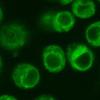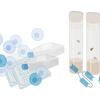Ying Xu, Raghuvir Viswanatha, Oleg Sitsel, Daniel Roderer, Haifang Zhao, Christopher Ashwood, Cecilia Voelcker, Songhai Tian, Stefan Raunser, Norbert Perrimon, and Min Dong. 2022. “
CRISPR screens in Drosophila cells identify Vsg as a Tc toxin receptor.” Nature, 610, 7931, Pp. 349-355.
AbstractEntomopathogenic nematodes are widely used as biopesticides1,2. Their insecticidal activity depends on symbiotic bacteria such as Photorhabdus luminescens, which produces toxin complex (Tc) toxins as major virulence factors3-6. No protein receptors are known for any Tc toxins, which limits our understanding of their specificity and pathogenesis. Here we use genome-wide CRISPR-Cas9-mediated knockout screening in Drosophila melanogaster S2R+ cells and identify Visgun (Vsg) as a receptor for an archetypal P. luminescens Tc toxin (pTc). The toxin recognizes the extracellular O-glycosylated mucin-like domain of Vsg that contains high-density repeats of proline, threonine and serine (HD-PTS). Vsg orthologues in mosquitoes and beetles contain HD-PTS and can function as pTc receptors, whereas orthologues without HD-PTS, such as moth and human versions, are not pTc receptors. Vsg is expressed in immune cells, including haemocytes and fat body cells. Haemocytes from Vsg knockout Drosophila are resistant to pTc and maintain phagocytosis in the presence of pTc, and their sensitivity to pTc is restored through the transgenic expression of mosquito Vsg. Last, Vsg knockout Drosophila show reduced bacterial loads and lethality from P. luminescens infection. Our findings identify a proteinaceous Tc toxin receptor, reveal how Tc toxins contribute to P. luminescens pathogenesis, and establish a genome-wide CRISPR screening approach for investigating insecticidal toxins and pathogens.





